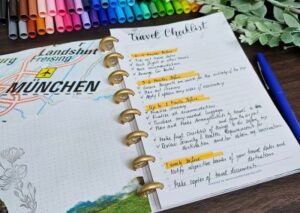
by Nikola | Jun 14, 2024 | Bullet Journaling
As a busy individual who loves all things creative, finding pockets of peace amidst chaos can be challenging. But what if there was a simple, meditative practice that could help you unwind, spark your creativity, and breathe new life into your bullet journal? Enter the world of tangle patterns—intricate, organic designs that are as therapeutic to create as they are beautiful to admire. 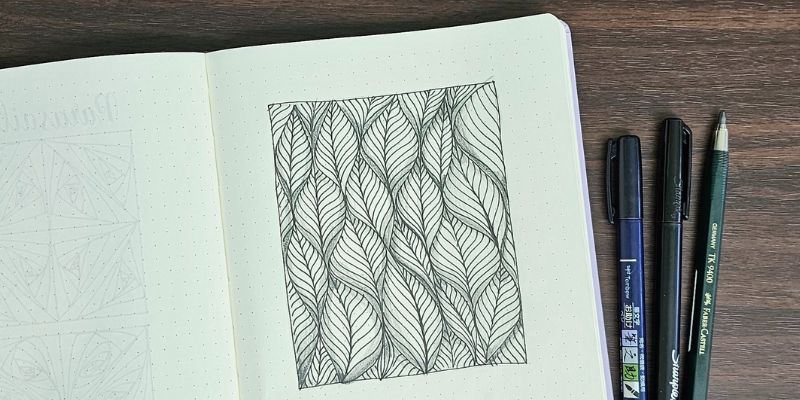
Unlock Your Creative Potential with Tangle Patterns
Don’t let the demands of life steal your creative spark. Embracing the therapeutic power of tangle patterns allows you to rediscover the joy of artistic expression. You can join a community of like-minded creators and embark on a journey of self-discovery, one stroke at a time. Immerse yourself in the mindful practice of creating intricate, organic designs. As you methodically apply each stroke, your mind will find solace, and your focus will sharpen, transporting you into a state of creative flow. The stunning, one-of-a-kind artwork you produce will reflect your unique artistic voice and provide a profound sense of accomplishment. By incorporating tangle patterns into your bullet journaling routine, you’ll unlock a myriad of benefits that extend far beyond the artistic realm. These include:
- reduced stress,
- increased patience and attention to detail,
- boosted creativity and problem-solving skills,
- and a profound sense of pride in your work.
Discover more Try out these 50+ stunning patterns to draw and use them in your planner, journal or art project.
Why Tangle Patterns Are a Game-Changer
Tangle patterns are more than just doodles – they’re a mindful artistic expression that can profoundly benefit your well-being. As you methodically apply stroke after stroke, your mind quiets and your focus sharpens, allowing you to tap into a state of creative flow. The result? Stunning, one-of-a-kind artwork that reflects your unique artistic voice. But the benefits continue beyond there. Incorporating tangle patterns into your bullet journal can boost relaxation and reduce stress by providing a calming, meditative outlet. It can also cultivate patience and attention to detail as you carefully construct each intricate design. Moreover, creating tangle patterns can ignite your creativity and problem-solving skills, allowing you to approach challenges from a fresh perspective. Perhaps most importantly, completing a tangle pattern spread in your journal provides an immense sense of accomplishment and pride in your artistic abilities.
What is the Zentangle Method?
While tangle patterns can be explored as a fun, artistic exercise, many find them to be a form of meditation and creativity closely tied to the Zentangle Method. Zentangle is an easy-to-learn, relaxing way to create beautiful images by drawing structured patterns called tangles. Created by Rick Roberts and Maria Thomas, it is often described as “meditation through pattern-making.” By focusing on one stroke at a time with no preconceived notion of the result, you can achieve increased relaxation, focus, and well-being. To learn more about the official Zentangle Method and its benefits, visit zentangle.com.
10 Captivating Tangle Patterns to Try Today
1. Hypnotic: 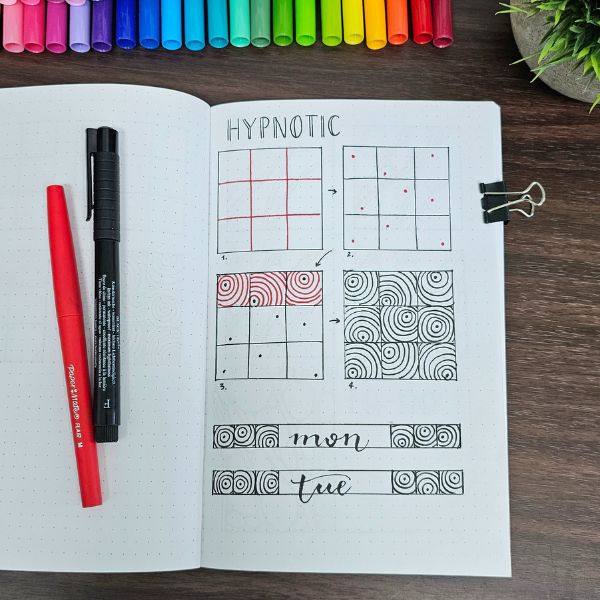 This mesmerizing pattern combines simple grid lines, dots, and circles, creating a hypnotic effect that draws the eye inward. Try using varied line weights and shading to add depth.
This mesmerizing pattern combines simple grid lines, dots, and circles, creating a hypnotic effect that draws the eye inward. Try using varied line weights and shading to add depth.
👉 Watch me draw Hypnotic.
2. Ornamato: 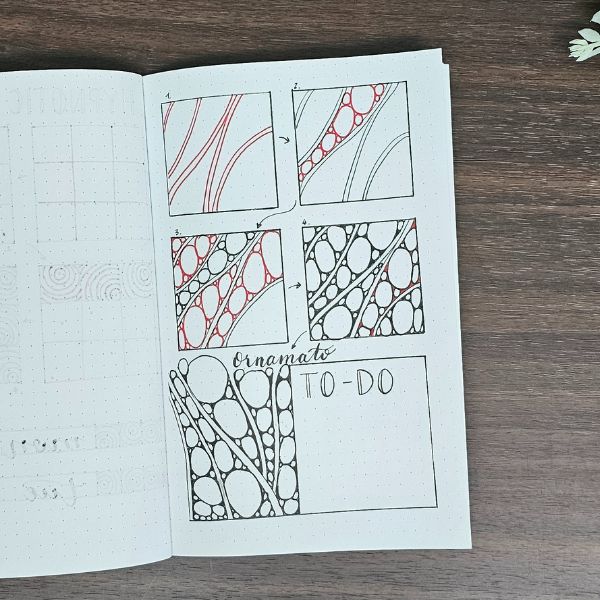 This intricate pattern is your go-to solution when filling a space quickly. Experiment with different motifs within the design for unique results.
This intricate pattern is your go-to solution when filling a space quickly. Experiment with different motifs within the design for unique results.
3. Shattuck: 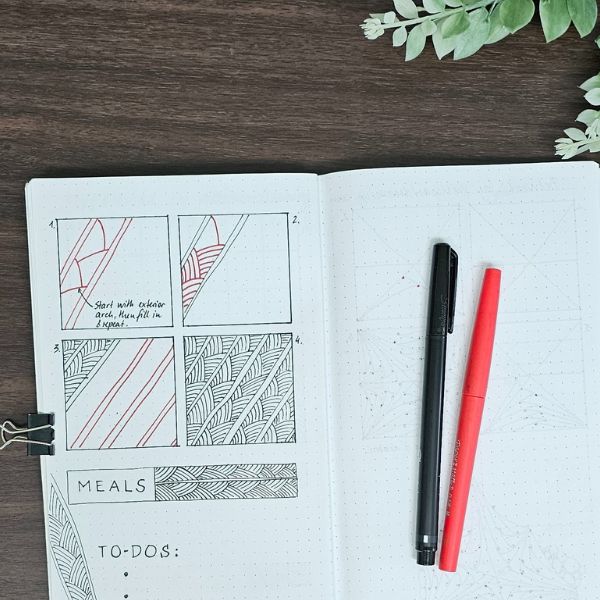 This pattern is perfect for framing headlines or sections in your bullet journal and adds a touch of elegance to any layout. Play with scale for visual interest.
This pattern is perfect for framing headlines or sections in your bullet journal and adds a touch of elegance to any layout. Play with scale for visual interest.
4. Betweed: 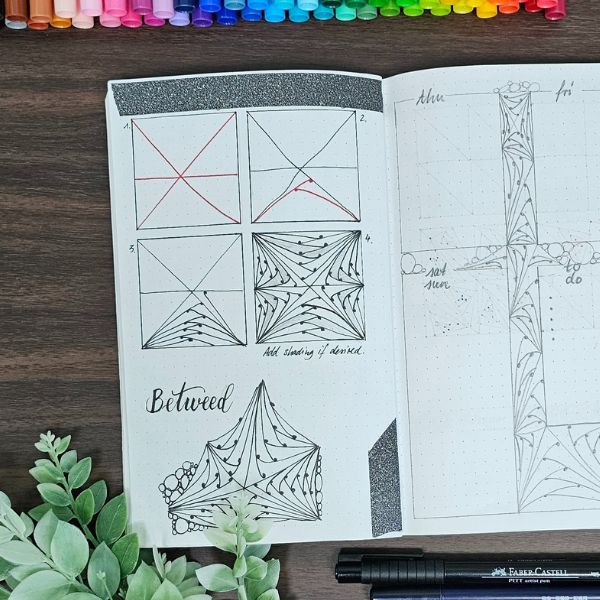 A versatile design that effortlessly complements and enhances your existing bullet journal spreads. Leave some areas sparse for contrast.
A versatile design that effortlessly complements and enhances your existing bullet journal spreads. Leave some areas sparse for contrast.
5. Parasail-Z: 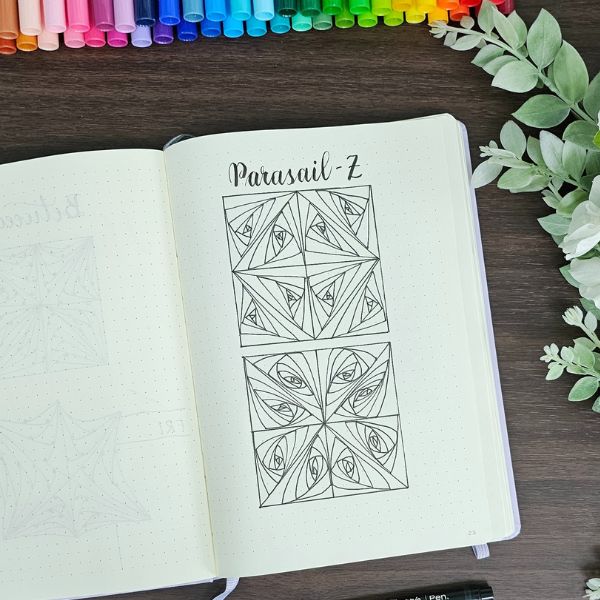 This pattern breathes life into even the most mundane daily headlines with its graceful curves and dynamic lines. Try using different line weights or colours.
This pattern breathes life into even the most mundane daily headlines with its graceful curves and dynamic lines. Try using different line weights or colours.
6. Leaflet: 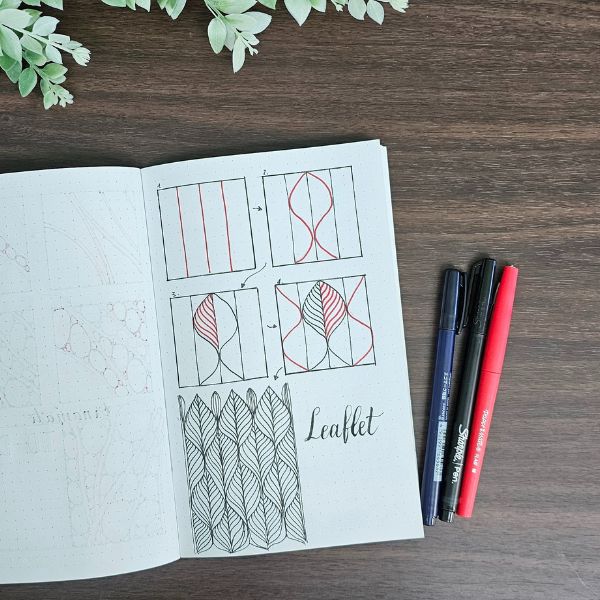 Embrace the organic beauty of nature with this leafy, curvy pattern and adapt it to suit your artistic vision. Add details like veining for depth.
Embrace the organic beauty of nature with this leafy, curvy pattern and adapt it to suit your artistic vision. Add details like veining for depth.
7. Featherfall: 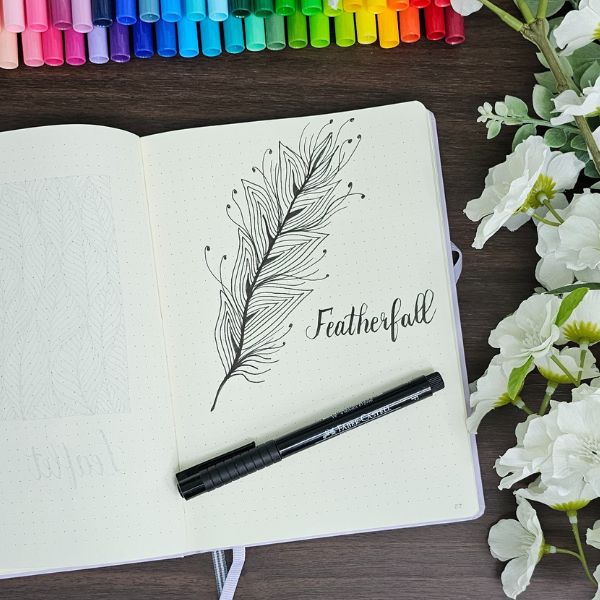 This pattern is sure to become a favourite for those who appreciate the delicate beauty of feathers. Use shading to create a sense of movement.
This pattern is sure to become a favourite for those who appreciate the delicate beauty of feathers. Use shading to create a sense of movement.
8. Joki: 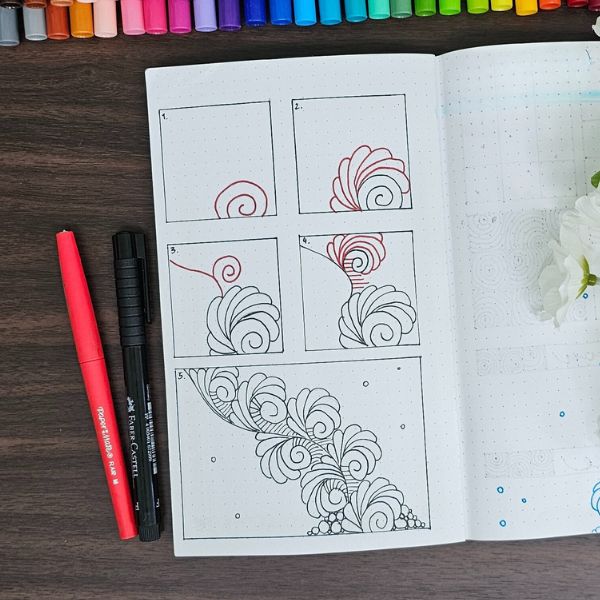 With its beachy, floral vibes, this swirling pattern is perfect for injecting a touch of whimsy into your bullet journal.
With its beachy, floral vibes, this swirling pattern is perfect for injecting a touch of whimsy into your bullet journal.
9. Scroll Feather: 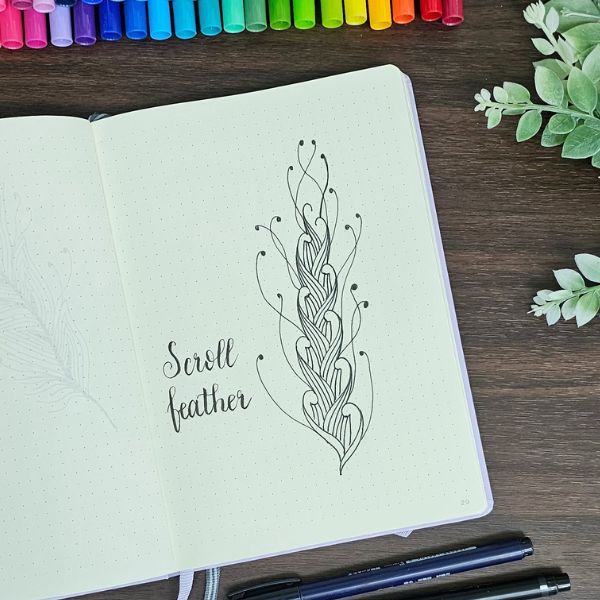 Another feather-inspired design that can stand alone or complement other tangle patterns. Vary the sizing for visual interest.
Another feather-inspired design that can stand alone or complement other tangle patterns. Vary the sizing for visual interest.
10. Decoo:  A simple yet eye-catching pattern with interwoven lines and loops that are great for borders, fillers, or ribbons.
A simple yet eye-catching pattern with interwoven lines and loops that are great for borders, fillers, or ribbons.
Unlock Your Creativity
Are you ready to tap into your creativity and elevate your bullet journaling practice? Subscribe to our newsletter and gain instant access to a world of inspiration and resources. From free monthly printable tangle pattern templates to expert tips and tricks for staying motivated on your goal-achieving journey, our community supports your creative expansion. Join us today and let your artistic journey unfold, one stroke at a time.

by Nikola | May 30, 2024 | Bullet Journaling
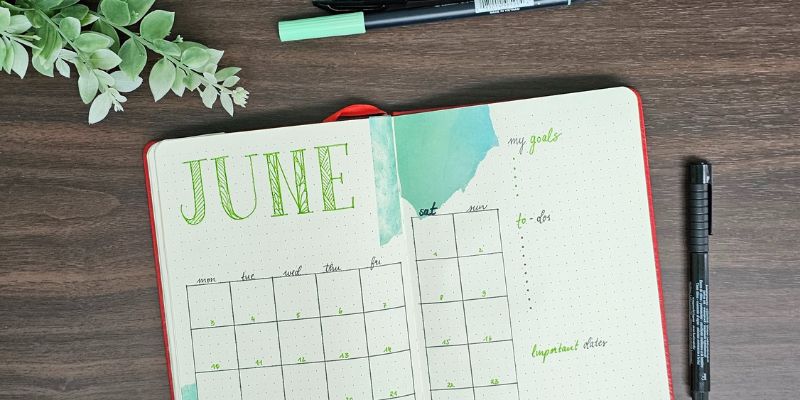
Starting a bullet journal can be daunting, especially seeing all the artistic spreads online. It might feel like you can’t compete, but the truth is, you don’t have to! Bullet journaling is about personal growth, organization, and creativity, and it can be as simple or elaborate as you want. Here are six easy-to-create bullet journal layouts that you can start with. They require minimal tools and can be embellished as you gain confidence.
Discover more
Not sure how to start a bullet journal? Check out this post where we give you a guide on to bullet journal like a pro.
Future Log
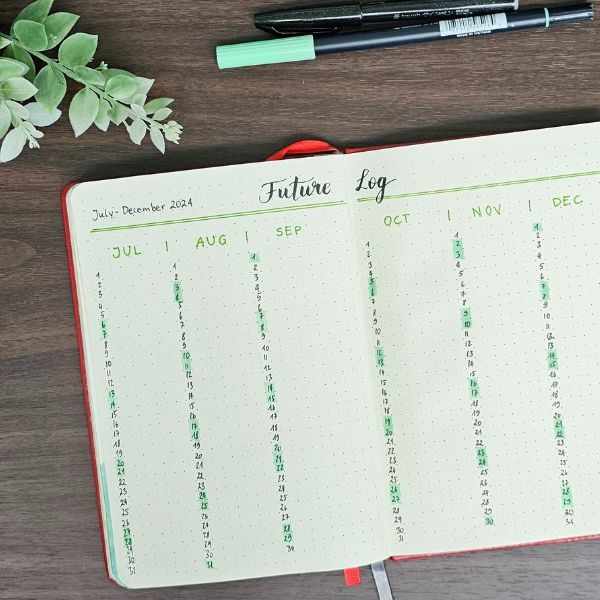
Why It’s Essential
The Future Log is a cornerstone of bullet journal layouts. It allows you to plan ahead and keep track of important dates and events. It’s perfect for mapping out the year at a glance.
How to Create It
- Divide your page: Use a pencil and ruler to divide a two-page spread into six equal sections, three per page.
- Label each section: Write the names of the months at the top of each section.
- Add events: Use a black fine liner to jot down significant dates, such as birthdays, anniversaries, and holidays.
Embellishment Tips
- Washi Tape: Use colourful washi tape to highlight each month.
- Stamps: Add decorative stamps to mark important events.
Brain Dump
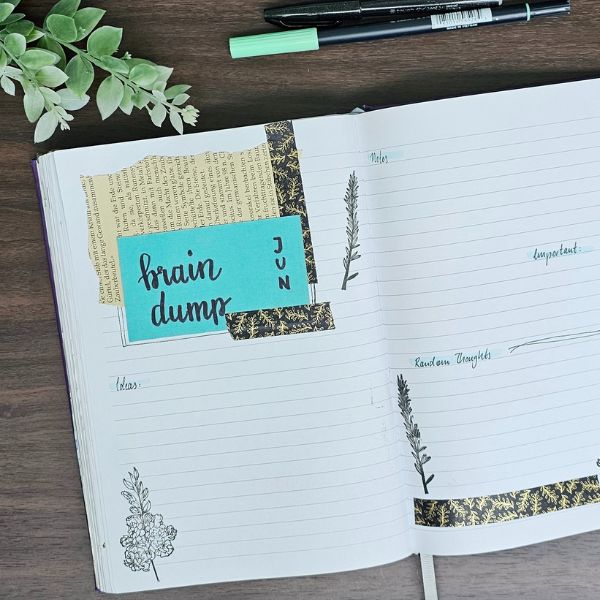
Why It’s Essential
A Brain Dump is a freeform spread where you can jot down ideas, thoughts, and tasks without worrying about organization. It’s a great way to clear your mind and stay focused.
How to Create It
- Blank page: Start with a blank page.
- Title: Write “Brain Dump” at the top.
- Write freely: Begin jotting down whatever comes to mind. No structure is needed!
Embellishment Tips
- Crayola Supertips: Use different colours to categorize your thoughts.
- Old Calendar: Cut out images or dates from an old calendar to create visual interest.
Gratitude Log
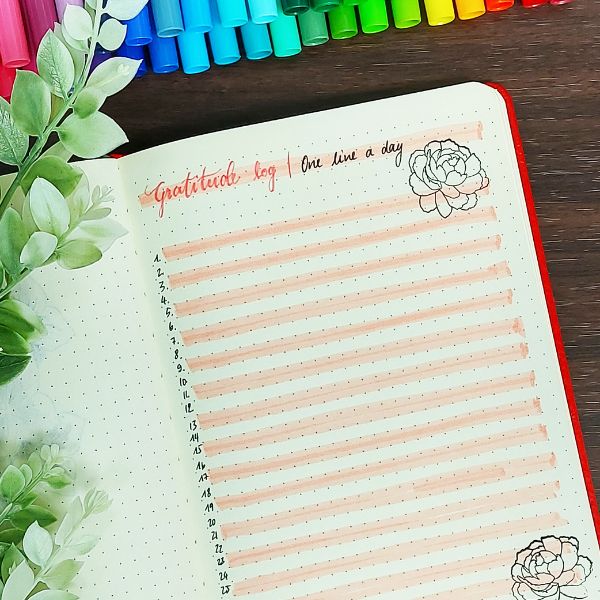
Why It’s Essential
Practicing gratitude can improve your mental health and overall well-being. A Gratitude Log helps you focus on the positive aspects of your life.
How to Create It
- Title: Write “Gratitude Log” at the top of the page.
- Daily Entries: Number the lines from 1 to 30 (or 31) for each day of the month.
- Log gratitude: Write down one thing you’re grateful for each day.
Embellishment Tips
- Tombow Brushpens: Use these pens to create a colourful gradient for your entries.
- Old Book Pages: Glue snippets from old book pages as backgrounds for a vintage look.
Monthly Log
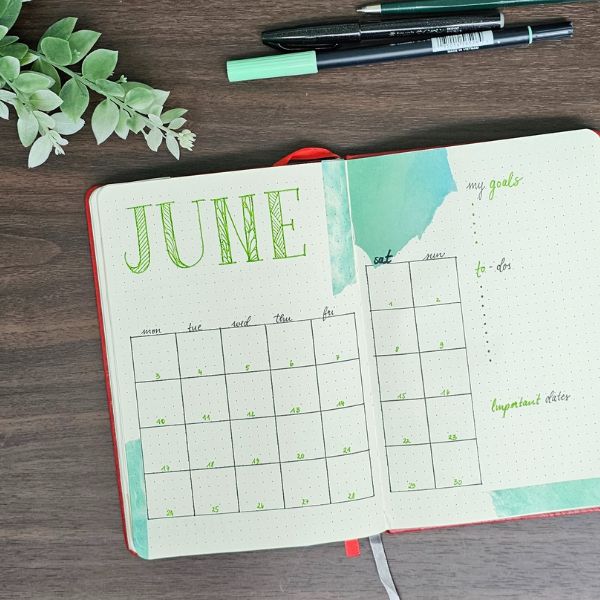
Why It’s Essential
A monthly log helps you plan your month, set goals, and track important tasks. It provides a clear overview, making it easier to manage your time.
How to Create It
- Title and Grid: Write the month at the top and draw a grid for the days of the month.
- Days and Dates: Label each box with the day and date.
- Add Tasks and Events: Fill in tasks, events, and appointments.
Embellishment Tips
- Washi Tape: Use tape to create borders or highlight specific dates.
- Stickers: Add motivational stickers to keep you inspired throughout the month.
Weekly Spread
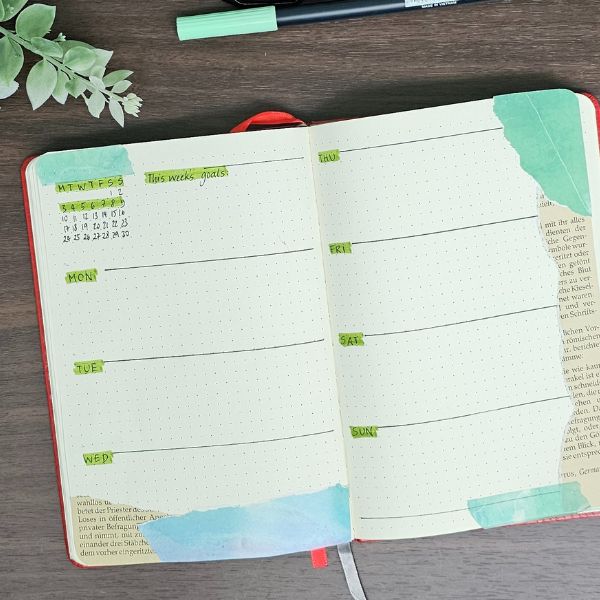
Why It’s Essential
The Weekly Spread breaks down your month into manageable chunks, helping you keep track of daily tasks and appointments.
How to Create It
- Layout: Divide two pages into seven sections, one for each day of the week.
- Titles: Label each section with the day of the week.
- Fill in tasks: Add your to-dos and appointments for each day.
Embellishment Tips
- Crayola Supertips: Use different colours for different types of tasks (work, personal, etc.).
- Doodles: Add simple doodles to make each section visually appealing.
Motivational Quote
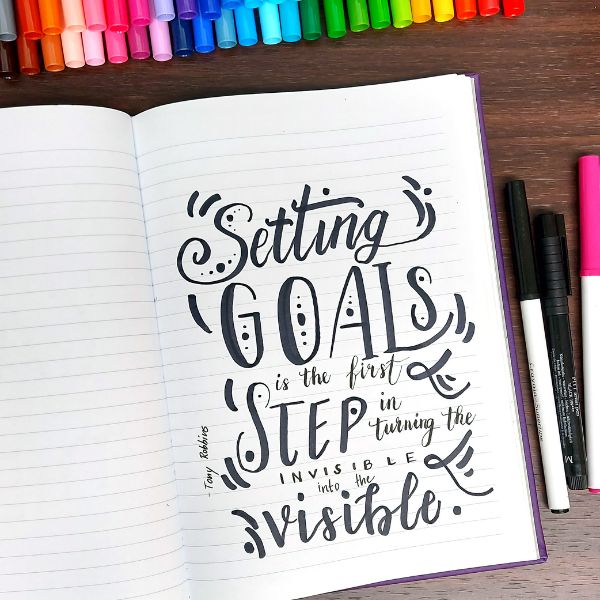
Why It’s Essential
Including motivational quotes in your bullet journal can provide a daily dose of inspiration and keep you focused on your goals.
How to Create It
- Choose a Quote: Select a quote that resonates with you.
- Center it on the Page: Write the quote in the center of the page using a black fine liner.
- Decorate: Add decorative elements around the quote.
Embellishment Tips
- Brush Lettering: Use Tombow brush pens to practice brush lettering techniques.
- Washi Tape and Stickers: Add tape and stickers for extra flair.
Basic Tools You’ll Need to Create Your Essential Bullet Journal Layouts
- Journal (we love the Yop & Tom dotted journal)
- Pencil
- Ruler
- Black fine liner
Optional Tools for More Colorful Spreads
- Washi tape
- Old calendar
- Pages from an old book
- Stamps
- Crayola Supertips
- Tombow brush pens
You can gradually build your confidence and creativity by starting with these simple bullet journal layouts. Remember, your bullet journal is a personal space for organization and expression, so make it uniquely yours. Happy journaling!
Follow Us for More Inspiration!
Ready to take your bullet journaling to the next level? Follow us on Instagram and YouTube for step-by-step tutorials, creative tips, and behind-the-scenes looks as we create these amazing layouts. Join our community of like-minded journal enthusiasts and get inspired!
Follow Us on Instagram
Stay updated with daily posts, stories, and reels showcasing beautiful bullet journal spreads, tips, and tricks. Share your creations with us using #YourBulletJournalJourney. @westcoastdreaming_planners
Watch video tutorials where we walk you through each layout, provide detailed instructions, and share pro tips to make your bullet journal truly unique. @WestCoastDreaming
Don’t miss out—click the links above and join our vibrant community today!
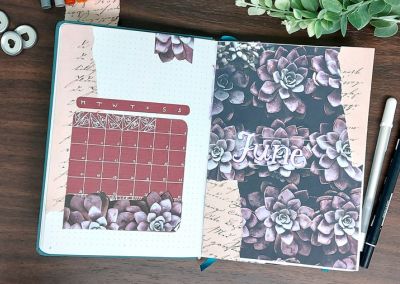
by Nikola | May 23, 2024 | Bullet Journaling
Are you new to bullet journaling and looking for creative ways to make the most of your planner? Here are the top 10 bullet journal ideas for beginners that will help you stay organized and enhance your productivity and creativity. Dive into these actionable tips and strategies to start your bullet journaling journey on the right foot.
Bullet Journal Idea #1: Monthly Log
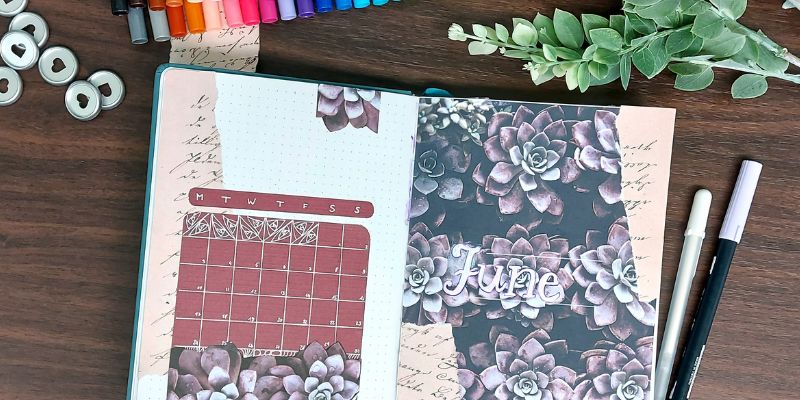
A monthly log is essential to any bullet journal, providing an overview of the entire month. In this section, you can list important dates, appointments, birthdays, and goals. Visualizing the month ahead lets you prioritize tasks and ensure nothing important slips through the cracks. Decorating your monthly log with themes, stickers, or colours that inspire you can make the process more enjoyable and visually appealing.
How to Create a Monthly Log
- Step 1: Draw a calendar or list the days of the month.
- Step 2: Mark significant dates, deadlines, and events.
- Step 3: Add a section for monthly goals and to-dos.
Discover
Craft your Perfect Month: 15 Creative Bullet Journal Monthly Spreads for Busy Professionals
Bullet Journal Idea #2: Weekly Spread
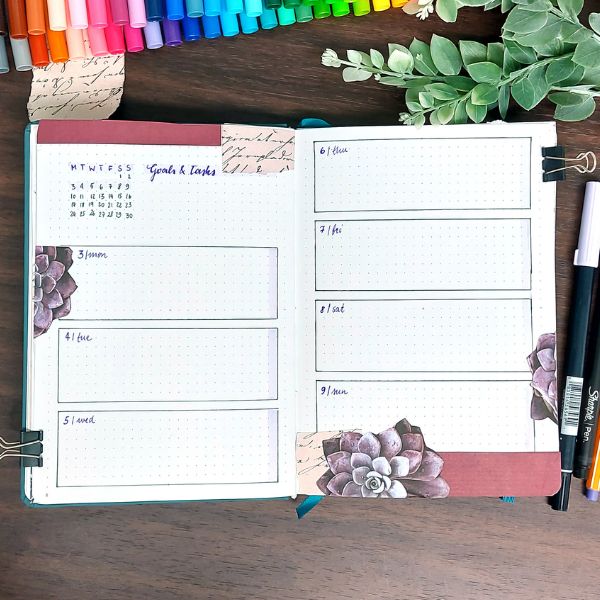
Breaking down your monthly log into weekly spreads allows for more detailed planning. This section helps you organize tasks and appointments every week, providing a clear roadmap for each day. Allocate sections for each day of the week and include to-do lists, appointments, and notes. This granular approach ensures you stay on top of your weekly commitments without feeling overwhelmed.
Tips for an Effective Weekly Spread
- Visual Hierarchy: Use different font sizes or colours to distinguish between tasks, events, and notes.
- Flexibility: Leave some space for unexpected tasks or changes.
- Reflection: Review what you’ve accomplished at the end of the week and plan for the next week.
Bullet Journal Idea #3: Habit Tracker
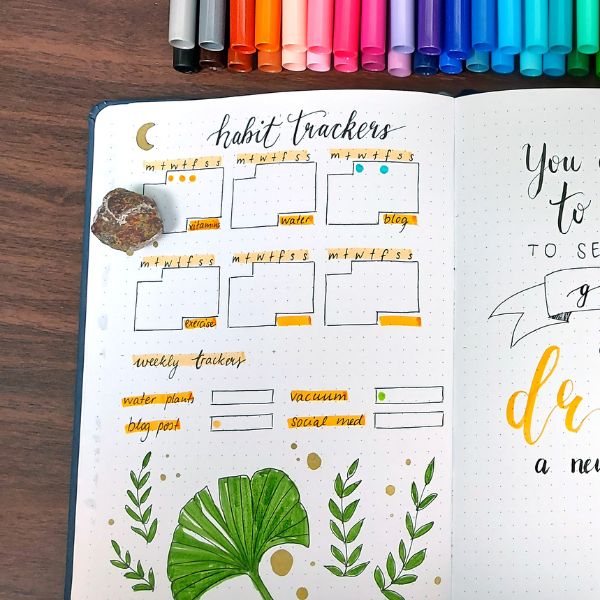
A habit tracker is a powerful tool for building and maintaining new habits. Create a grid with the habits you want to track on one axis and the days of the month on the other. Check off each day you complete a habit. This visual representation keeps you motivated and accountable, making it easier to see your progress and areas for improvement.
Popular Habits to Track
- Drinking water
- Exercising
- Reading
- Meditating
- Sleeping hours
Find more ideas in this article 80 Habit Tracker Ideas for Your Bullet Journal.
How to Customize Your Habit Tracker
- Colour Coding: Use different colours for different habits.
- Stickers and Icons: Add visual elements to make it more engaging.
- Reflection Space: Include a section to write about your progress and challenges.
Discover
How to Achieve More, Stress Less: The Art of Harnessing Habit Tracker Printables for a Balanced Life
Bullet Journal Idea #4: Gratitude Log

Practicing gratitude can significantly improve your mental well-being. Dedicate a section of your bullet journal to write down things you are grateful for each day. This simple practice helps you focus on the positive aspects of your life and cultivate a more optimistic mindset.
Benefits of a Gratitude Log
- Positive Mindset: Encourages you to focus on the good in your life.
- Stress Reduction: Helps to alleviate stress by shifting your focus from problems to blessings.
- Improved Mood: Regularly reflecting on positive aspects can boost your overall mood.
Bullet Journal Idea #5: Goal Setting Pages
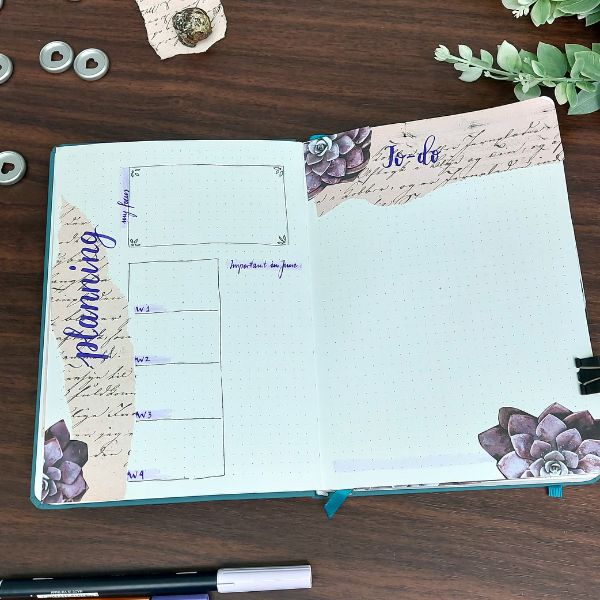
Setting clear, actionable goals is critical to personal and professional growth. Use your bullet journal to outline your short-term and long-term goals. Break them down into smaller, manageable tasks and set deadlines. Regularly reviewing and updating these pages will keep you on track and motivated to achieve your ambitions.
Goal Setting Tips
- SMART Goals: Ensure your goals are Specific, Measurable, Achievable, Relevant, and Time-bound.
- Vision Board: Include images or quotes that represent your goals.
- Progress Tracking: Regularly update your progress and adjust your plans as needed.
Bullet Journal Idea #6: Brain Dump Pages
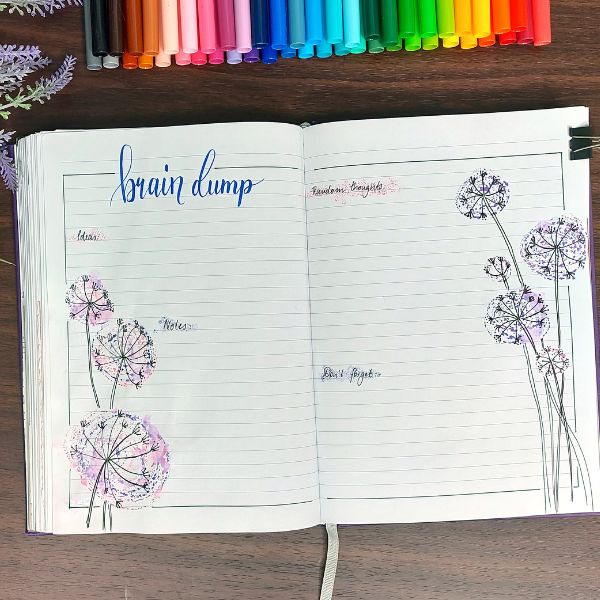
Sometimes, you just need a space to jot down random thoughts, ideas, and tasks. A brain dump page is perfect for this. Use it to declutter your mind by transferring everything onto paper. Later, you can sort through these notes and decide what to prioritize.
How to Use a Brain Dump Page
- Daily or Weekly: Schedule regular brain dump sessions.
- Categorize: Once you’ve written everything down, categorize the items into actionable tasks, ideas, and notes.
- Review: Review your brain dump pages to ensure everything is taken care of.
Bullet Journal Idea #7: Mood Tracker
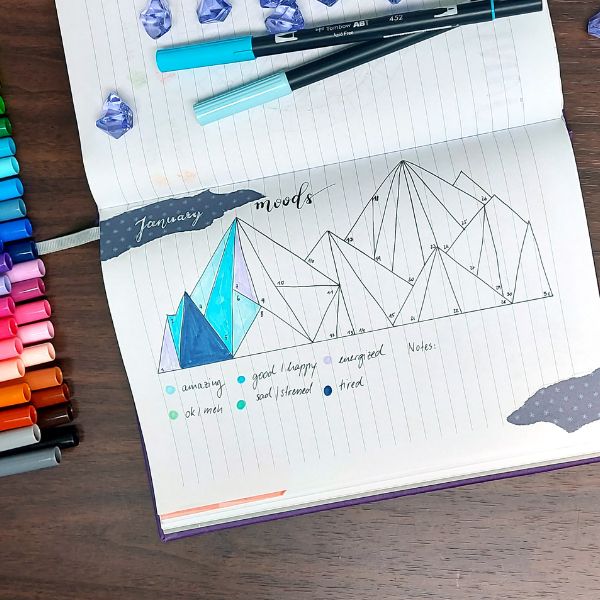
Understanding your emotional patterns can be incredibly insightful. Design a mood tracker where you can colour-code your daily moods. Over time, this will help you identify triggers and trends in your emotional health, allowing you to make necessary adjustments.
Creating a Mood Tracker
- Daily Log: Colour a box or draw an emoji representing your mood each day.
- Monthly Overview: Review your mood patterns at the end of the month.
- Reflection: Use this information to identify what influences your moods and how to improve your emotional well-being.
Bullet Journal Idea #8: Meal Planner
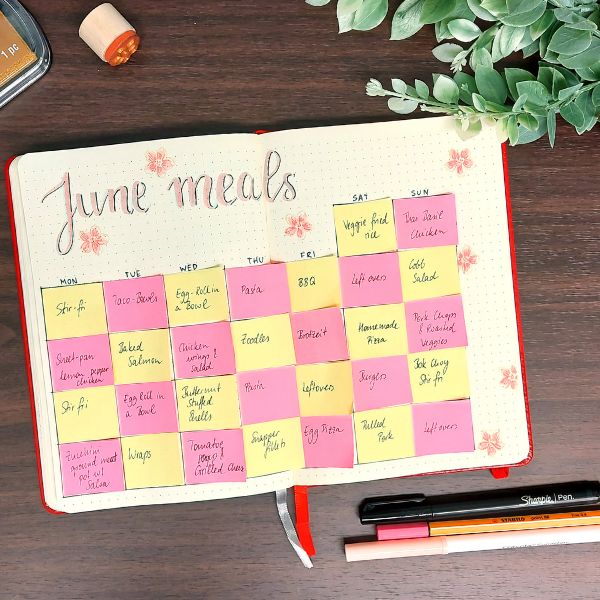
Planning your meals can save time and money and promote healthier eating habits. Create a weekly meal planner in your bullet journal. Include sections for breakfast, lunch, dinner, and snacks. Remember to leave space for grocery lists and recipe ideas.
Benefits of Meal Planning
- Healthier Choices: Plan balanced meals ahead of time.
- Budget-Friendly: Reduce grocery costs by planning meals based on sales and discounts.
- Time-Saving: Spend less time deciding what to eat each day.
Bullet Journal Idea #9: Exercise Log
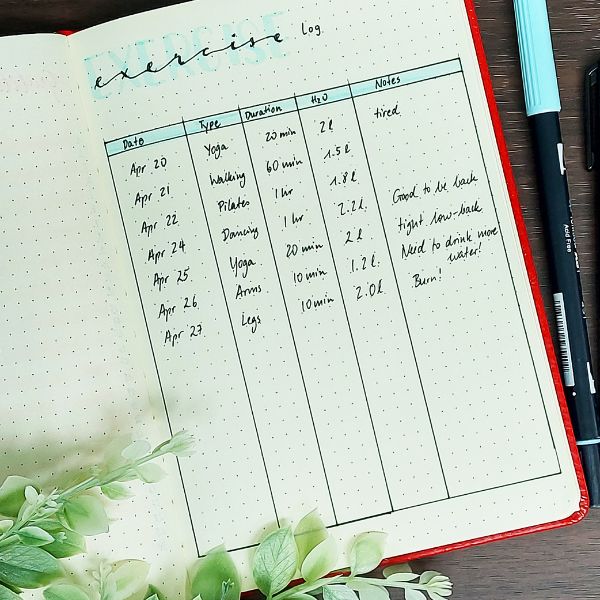
Staying active is crucial for overall well-being. Keep track of your workouts in an exercise log. Note the type of exercise, duration, and any progress or achievements. This log tracks your fitness journey and motivates you to stay consistent.
How to Track Your Exercise:
- Routine: List your workout routines and schedules.
- Progress: Record improvements in strength, endurance, or flexibility.
- Achievements: Celebrate milestones like running a certain distance or lifting a specific weight.
Bullet Journal Idea #10: Budget Tracker
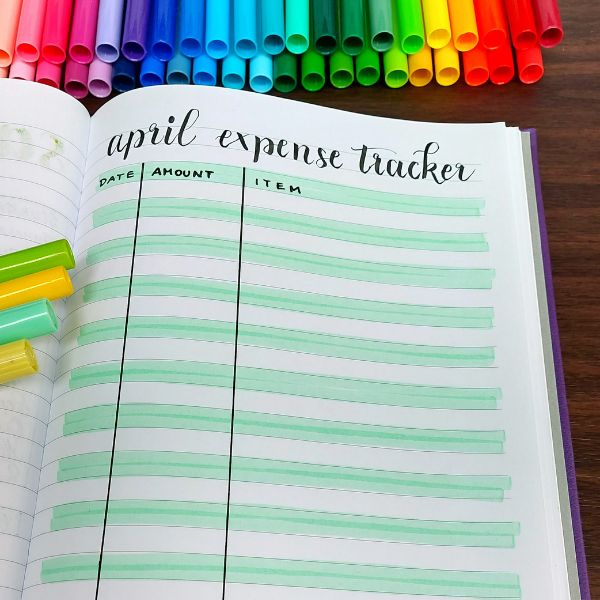
Managing your finances is easier with a budget tracker. Record your income, expenses, and savings goals. Categorize your spending and regularly review your budget to ensure you are on track. This will help you make informed financial decisions and achieve your monetary goals.
Budget Tracking Tips
- Monthly Overview: Start with a monthly income and expense overview.
- Categories: Break down expenses into categories like groceries, rent, entertainment, and savings.
- Review: Regularly review your budget to adjust for changes or unexpected expenses.
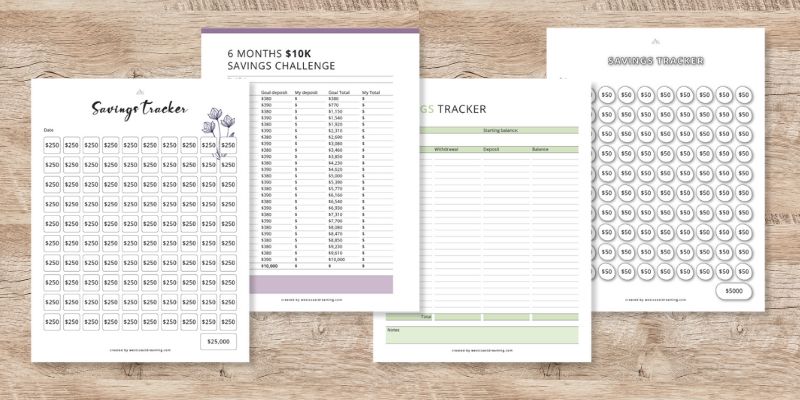
Free Resource
Learn more about how Savings Trackers can support you to reach your savings goals and download these free printables today.
In Summary
Starting a bullet journal can be an enriching experience, blending organization with creativity. These top 10 bullet journal ideas for beginners provide a strong foundation for anyone looking to enhance their productivity, track their progress, and express themselves. Remember, the key is to customize your bullet journal to fit your unique needs and preferences. Happy journaling!
By integrating these bullet journal ideas for beginners into your routine, you can create a personalized planner that helps you stay organized and fuels your creativity and personal growth. Whether you are a busy professional, student, or parent, these tips are tailored to make your bullet journaling journey effective and enjoyable.
Additional Tips:
- Start Simple: Don’t feel pressured to make everything perfect. Start with basic layouts and gradually incorporate more complex designs.
- Use Quality Supplies: Invest in good-quality pens, markers, and paper to enhance your journaling experience.
- Join a Community: Engage with other bullet journal enthusiasts on social media platforms like Instagram and Pinterest for inspiration and support.
- Stay Flexible: Your bullet journal should adapt to your changing needs. Don’t be afraid to modify your spreads and layouts as you see fit.
Bullet journaling is a versatile and dynamic tool that can help you achieve your goals, stay organized, and reflect on your personal growth. Embrace the process and make it your own!

by Nikola | May 16, 2024 | Bullet Journaling
Unleash Your Inner Organizer
Are you ready to take control of your life and supercharge your productivity? Welcome to this guide on how to bullet journal – a revolutionary method designed to help you organize your tasks, track your habits, and unleash your creativity like never before. Created by Ryder Carroll, the bullet journal method has taken the planning world by storm, offering a flexible and customizable approach to journaling that adapts to your unique needs and preferences.

This comprehensive guide will walk you through becoming a bullet journal pro. From setting up your journal to mastering essential techniques, you’ll learn everything you need to know to harness the power of the bullet journal method and unlock your full productivity potential. Get ready to transform your life, one bullet at a time!
The Bullet Journal is an analog system designed to track the past, organize the present, and plan for the future.
– Ryder Carroll, Inventor of the Bullet Journal method
How to Bullet Journal: Rapid Logging and Migration
Rapid logging is the cornerstone of the bullet journal method, allowing you to capture tasks, events, and notes with speed and simplicity. Each entry is written in short, concise sentences, using bullet points to categorize different types of information. For example, a dot signifies a task, a circle represents an event, and a dash indicates a note. Rapid logging lets you record information in real time, keeping your journal up-to-date and actionable.
Migration is reviewing your tasks and deciding what to do with them next. Review your open tasks at the end of each month and determine whether they align with your goals and priorities. Still relevant tasks can be migrated to the next month, while those no longer necessary can be crossed out or discarded. Migration helps you focus on what matters and prevents tasks from falling through the cracks.
Understanding the Difference Between Collections, Spreads, and Logs
Collections are themed pages that gather related information in one place. They can range from simple lists to more elaborate trackers and logs. Examples of collections include reading lists, gratitude journals, and habit trackers. Collections allow you to organize information in a way that makes sense to you, helping you stay focused and motivated on your goals.
Spreads are two-page layouts that plan specific periods, such as monthly and weekly spreads. Spreads provide a visual overview of your schedule and goals, allowing you to see everything at a glance. Depending on your needs and preferences, they can include calendars, to-do lists, habit trackers, and more.
Logs are chronological records of events, tasks, and notes. Daily logs capture your activities and priorities on a day-to-day basis, while future logs and monthly logs help you plan ahead and stay organized. Logs provide a snapshot of your life and allow you to track your progress over time.
Here are a few ideas of typical bullet journal pages:
-
-
- Books to read or movies to watch
- Favourite quotes
- Weekly meal planner
- Savings tracker
- Expenses chart
- Workout Log
- Weight loss chart
- Habit Tracker
- Week at a glance
- Daily tasks
- Places to visit
How to Bullet Journal Step-by-Step Guide
Step 1: Gather Your Supplies
Before diving into the world of bullet journaling, it’s essential to gather the necessary supplies. All you need is a notebook and a pen – it’s that simple!
Check out these 6 super simple page layouts to get you started now.
Opt for a notebook with a dot grid or blank pages, as they provide the flexibility needed for bullet journal layouts. Of course, you can use any journal that you have or like. I started with lined journals and worked my way up to a dot grid. Now, I don’t ever want to go back to lined, but it was an excellent start to see if I liked this type of journaling. As for pens, choose ones that won’t bleed through the pages and feel comfortable to write with.
With your supplies in hand, you’re ready to embark on your bullet journaling journey!
Discover more
Check out these 10 essential supplies for Bullet Journaling Success
Step 2: Set Up Your Key
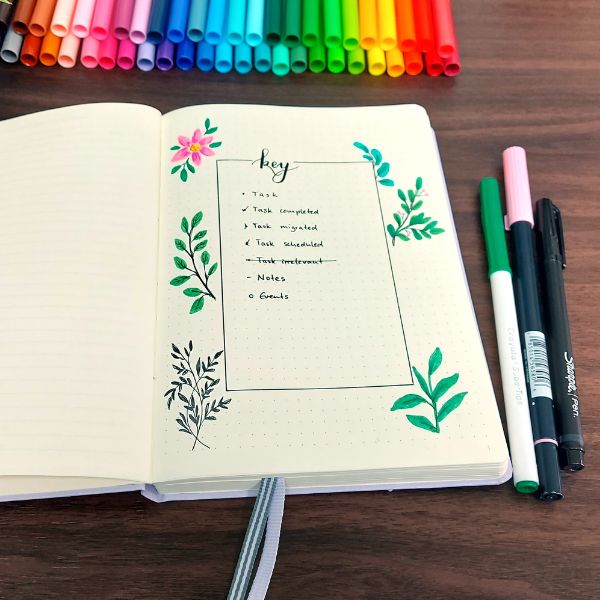
The key is the backbone of the bullet journal method, helping you quickly categorize tasks and events. Start by creating a legend that assigns symbols to different types of entries – for example, a dot for tasks, a circle for events, and a dash for notes. Customize your key to suit your preferences, and don’t forget to leave space for future additions as your journal evolves.
Step 3: Set Up Your Index
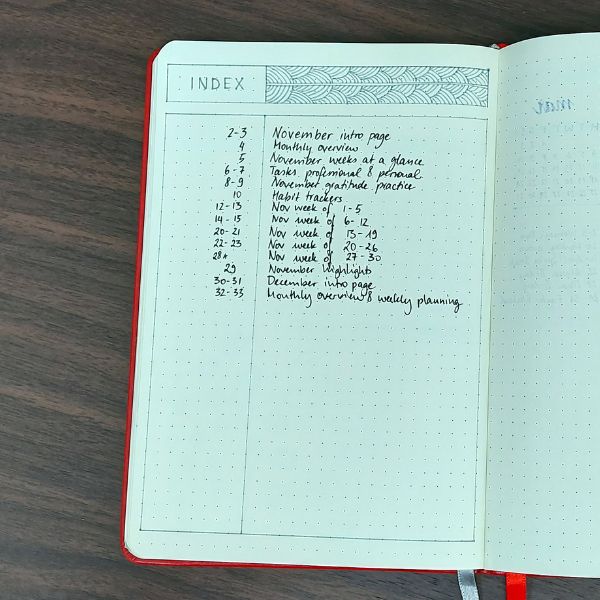
The index is your bullet journal’s roadmap, helping you easily navigate your entries. Some journals already come with an index, simplifying the setup process. If your journal does not already have this pre-printed, reserve the first few pages for the index, where you’ll list the page numbers of key spreads and collections. As you add new entries, update the index to track where everything is located. The index ensures you can quickly find important information whenever needed, making your bullet journal more efficient and organized.
Step 4: Create Your Future Log
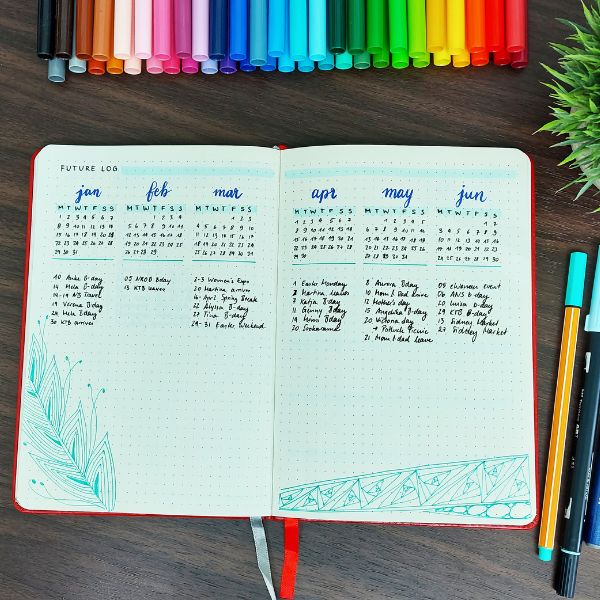
In the future log, you’ll jot down upcoming events, appointments, and deadlines for the months ahead. Divide your page into sections for each month, leaving enough space to write down important dates. As new events arise, add them to your future log to keep track of your schedule at a glance.
Step 5: Set Up Your Monthly Spread
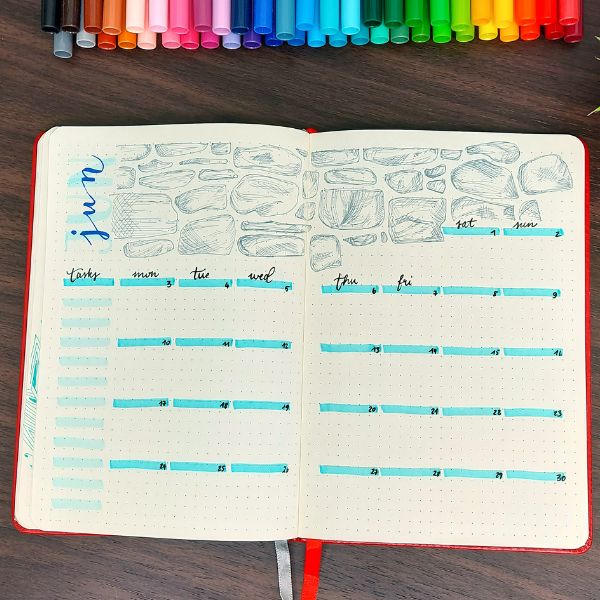
At the beginning of each month, create a monthly spread to plan your goals and priorities. Use a two-page spread to write down important dates, goals, and tasks for the month ahead. Consider adding a habit tracker to monitor your progress on daily habits and routines. Your monthly spread is a roadmap for the coming weeks, keeping you focused and on track toward your goals.
Discover more
15 Creative Bullet Journal Monthly Spreads for Busy Professionals
Step 6: Create Your Weekly Spreads
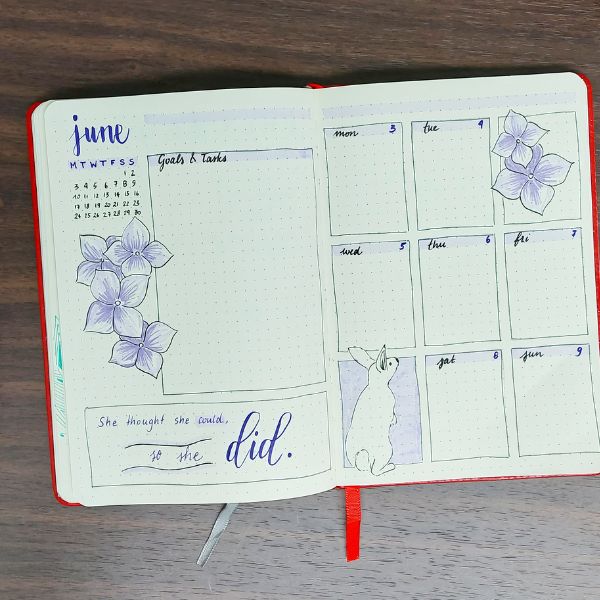
Weekly spreads provide a snapshot of your upcoming week, allowing you to plan your schedule and priorities in detail. Design your weekly spread layout to include space for each day of the week and sections for tasks, events, and goals. Consider incorporating a habit tracker or meal planner into your weekly spread to keep track of recurring activities and routines. Customize your weekly spreads to suit your needs and preferences, whether you prefer a structured layout or a more minimalist approach. Review and update your weekly spreads regularly to stay on top of your commitments and make adjustments as needed.
Read more
7 Ways Bullet Journaling Weekly Spreads Boost Productivity and Creativity
Step 7: Dive Into Daily Logging
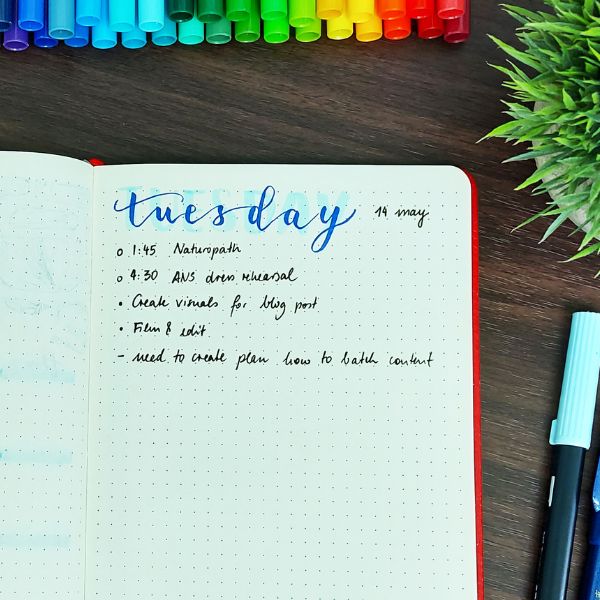
The heart of the bullet journal method lies in daily logging—the process of rapidly logging tasks, events, and notes on a daily basis. Start a new page in your journal each day and jot down the tasks you need to accomplish. Use your key to mark tasks as completed, migrated, or scheduled for a later date. Rapid logging lets you capture information quickly and efficiently, keeping your journal clutter-free and easy to navigate.
And what about the surprising benefits?
Bullet journaling is about flexibility—it can be as simple or creative as you like. It is YOUR system! If it starts to feel like a chore, remember why you started and change your approach. Intersperse your logs with an inspirational quote, photos, or cut-outs from magazines. Anything that inspires you can go into this system. Remember, the system is there for you, not the other way around.
Bullet journaling is about reducing stress. The manual task of writing things down acts as a brain dump. When your mind is frantically trying to remember everything or is stuck on one idea or task, the act of writing things down quiets your mind, giving you the ability to let go, even if it is just a little bit.
Bullet journaling is about self-motivation. Setting and reviewing your goals every day, week, and month keeps you motivated to see them through. By tracking your achievements, you will become quickly aware of your progress, which will fuel your motivation further.
Last but not least, bullet journaling is great for achieving your goals. By being organized and tracking your progress, you will find yourself on the path to success when it comes to achieving your goals. Every Sunday, when you plan your week ahead, or whenever you want to do this, you organize your thoughts, make time for things that are important to you, and ultimately create your reality.
Unleash Your Potential
Congratulations! You’ve completed your crash course in how to bullet journal and are well on your way to unlocking your productivity potential. By following the steps outlined in this guide and incorporating the tips for success, you’ll harness the full power of the bullet journal method and transform your life in ways you never thought possible.
So, are you ready to take your productivity to new heights? Start your bullet journaling journey today and unlock your full potential. Experiment with different layouts, spreads, and collections to create a journal tailored to your unique needs and preferences. Whether you’re a seasoned journaler or just starting, the possibilities are endless with bullet journaling. Get started now and watch as your productivity soars!
Do you love bullet journals but are still determining if you want to create new spreads each week?
Check out these resources that can help you on your way:
Free Resources, such as printable trackers and layouts, and build your own planner. All you need is a binder, a printer and a hole punch.
Based on the bullet journal method, our Three-Month Planner is highly customizable and provides more guidance on achieving your goals.
Get started now and watch as your productivity soars!
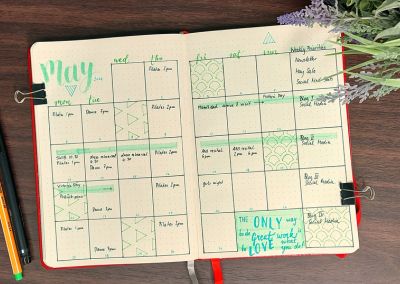
by Nikola | Apr 25, 2024 | Bullet Journaling
In the world of bullet journaling, a simple notebook turns into a versatile tool for quickly organizing your hectic schedule and achieving your goals. Today, we’ll explore 15 creative bullet journal monthly spreads explicitly designed for individuals like you who juggle multiple responsibilities and strive for creativity and peak productivity. From time-blocking techniques to meal-planning hacks, each spread offers actionable insights to help you craft your perfect month and reclaim control of your busy life. Get ready to revolutionize the way you plan and organize your life with these creative bullet journal monthly spreads.
1. The Master Schedule Spread
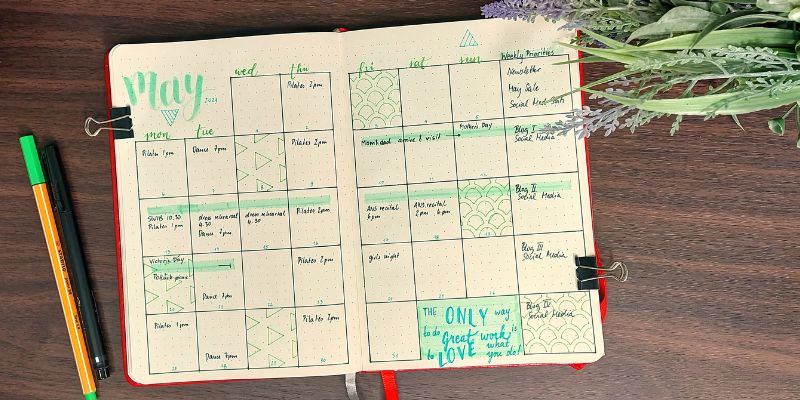
Take control of your time with a master schedule spread that breaks down your month into manageable chunks. Use colour-coded blocks to designate work hours, meetings, and personal commitments, allowing you to visualize your schedule at a glance and prioritize tasks effectively.
2. The Goal Tracker Spread
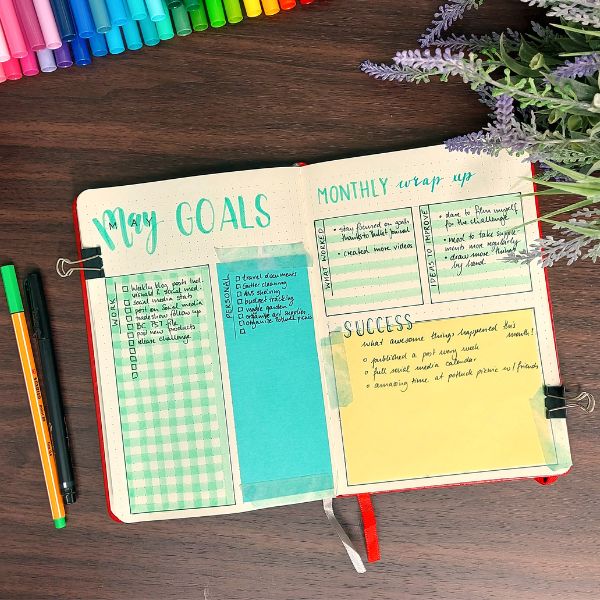
Create a dedicated goal tracker spread to help you stay on track with your professional and personal goals. Divide your goals into career, health, and personal development categories and track your progress throughout the month. Celebrate your achievements and adjust your strategy as needed to ensure success.
3. The Monthly Cleaning Routine Spread
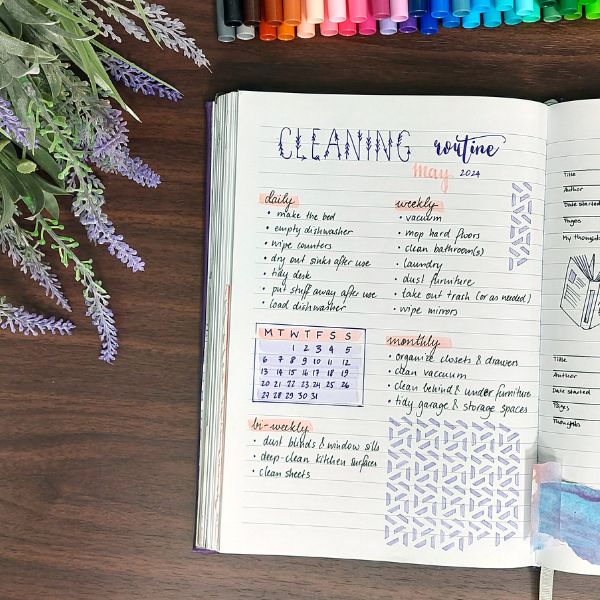
Keep your living space organized and clutter-free with a monthly cleaning routine spread. Divide tasks by room or area of the house and schedule specific cleaning tasks for each week of the month. Maintaining a clean and tidy home environment Includes vacuuming, dusting, decluttering, and deep cleaning.
4. The Mood Tracker Spread
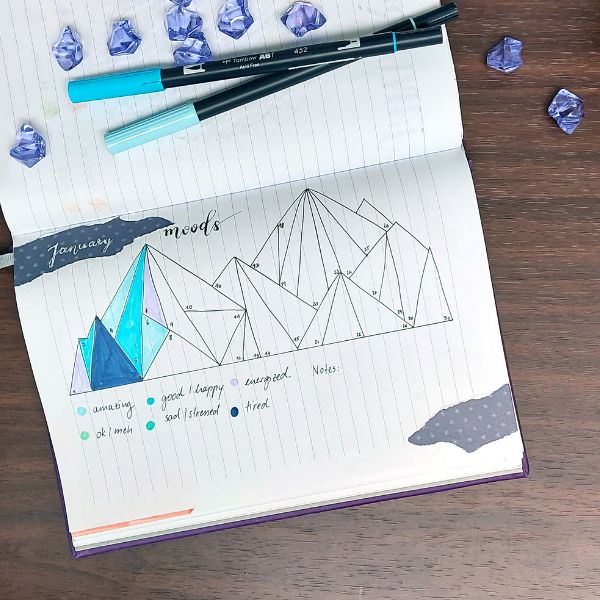
Take care of your mental well-being with a mood tracker spread that allows you to monitor your emotions throughout the month. Use different colours or symbols to represent your mood each day, and identify patterns or triggers that affect your mental health. Practice self-care strategies based on your mood insights to maintain balance and resilience.
5. The Habit Tracker Spread
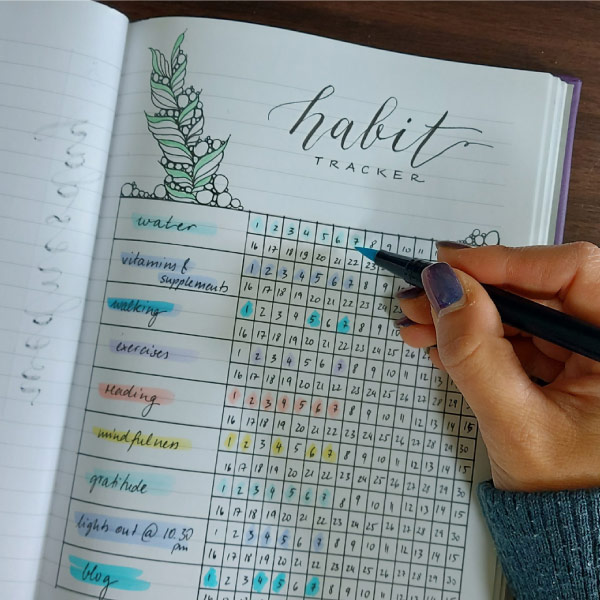
Cultivate positive habits and eliminate bad ones with a habit tracker spread that holds you accountable for your daily routines. Whether exercising, meditating, or reading, track your progress and identify patterns to optimize your habits for success.
6. The Financial Tracker Spread
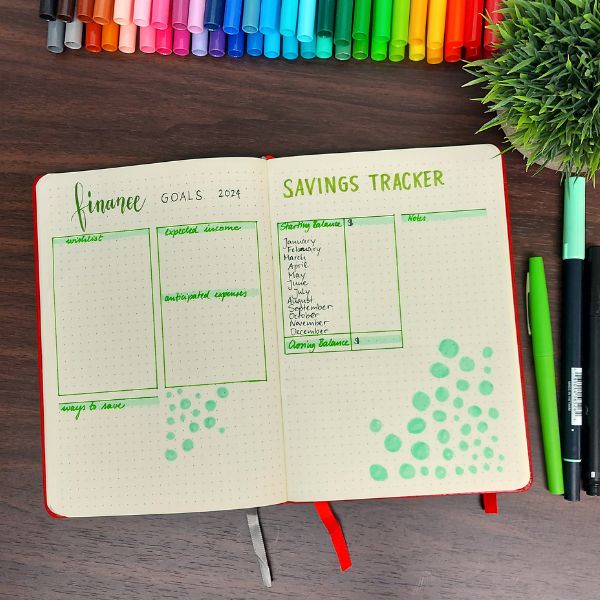
Take control of your finances with a financial tracker spread that monitors your income, expenses, and savings goals. Keep tabs on your budget, track recurring payments, and identify areas where you can cut costs or increase savings to achieve your financial objectives.
7. The Brain Dump Spread
Clear your mind and declutter your thoughts with a brain dump spread that serves as a repository for ideas, tasks, and random thoughts. Use this spread to capture everything on your mind and prioritize your tasks for the month ahead.
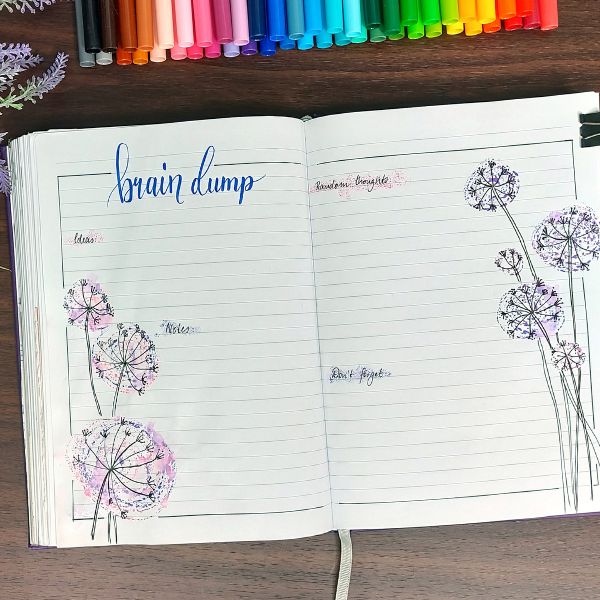
8. The Reflection Spread
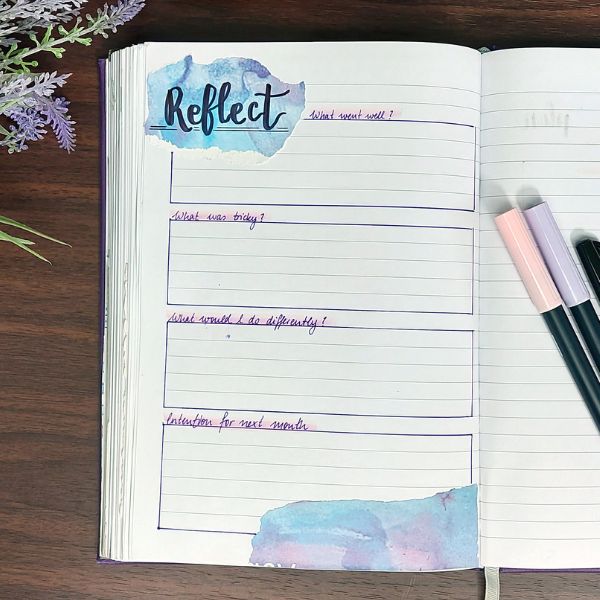
Reflect on your achievements and lessons learned with a dedicated reflection spread at the end of each month. Review your successes, challenges, and areas for improvement, and set intentions for the month ahead to ensure continuous growth and development.
9. The Self-Care Tracker Spread
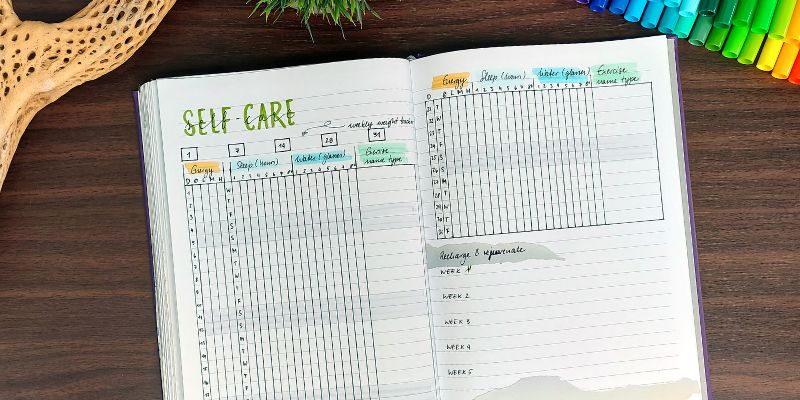
Prioritize your well-being with a self-care tracker that encourages you to invest in yourself regularly. Track activities such as exercise, sleep, hydration, and relaxation, and ensure you’re dedicating time to recharge and rejuvenate amidst your busy schedule.
10. The Project Planner Spread
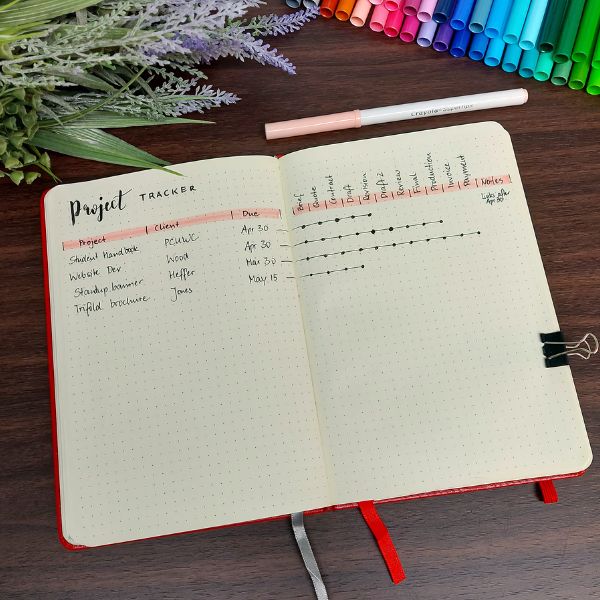
Keep your projects on track and deadlines in check with a project planner spread that breaks down your tasks into actionable steps. Use this spread to outline project timelines, milestones, and deliverables, ensuring you stay organized and focused on your goals.
11. The Gratitude Journal Spread
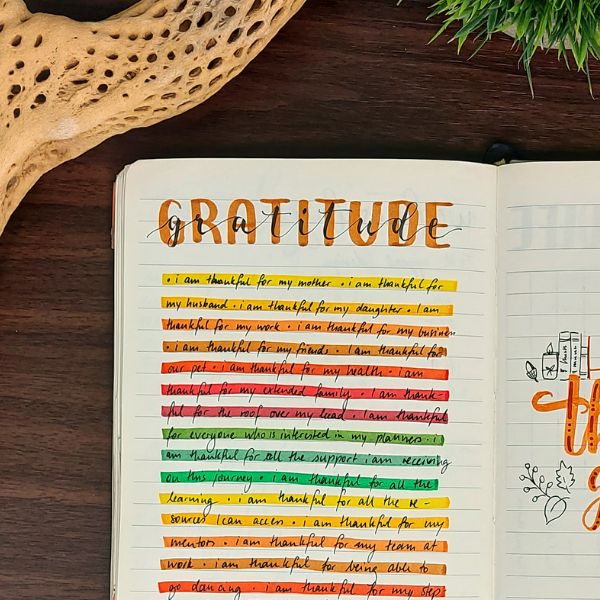
Cultivate an attitude of gratitude with a gratitude journal spread that prompts you to reflect on the positive aspects of your life. Take a moment each day to jot down things you’re thankful for, whether a small win at work or a meaningful interaction with a loved one.
12. The Vision Board Spread
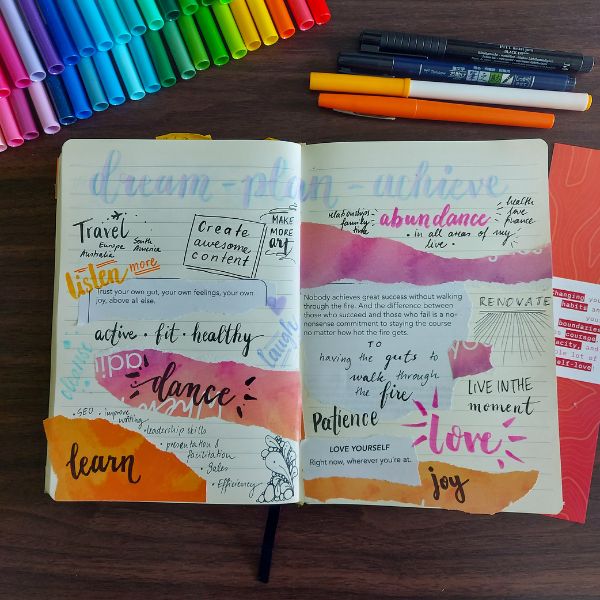
Manifest your dreams and aspirations with a vision board spread that visualizes your goals and desires. Cut out images, quotes, and affirmations that inspire you and arrange them on your spread to create a powerful visual representation of your aspirations.
13. The Reading Log Spread
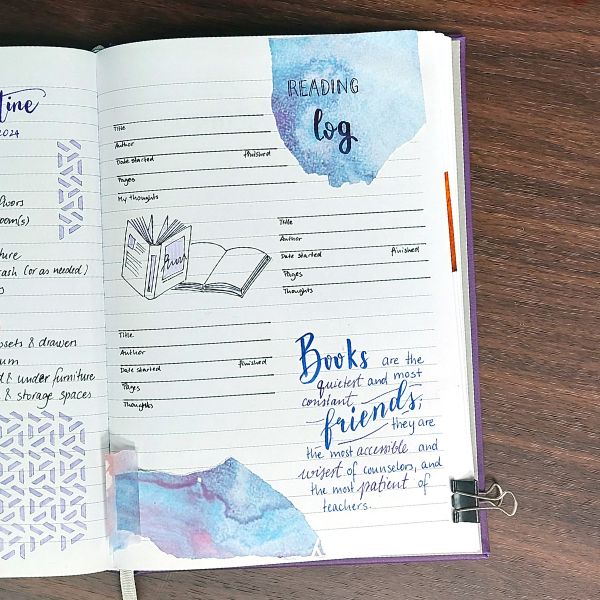
Make time for personal development and leisure reading with a reading log that tracks your literary journey. List out the books you plan to read or have read, along with your thoughts, reviews, and recommendations for fellow bookworms.
14. The Travel Planner Spread
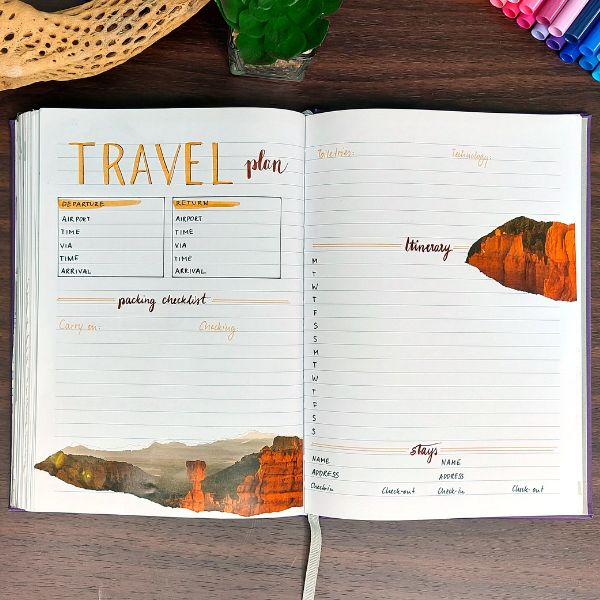
Plan your adventures and explore new destinations with a travel planner spread that organizes your travel itinerary, packing list, and expenses. Whether you’re jet-setting for work or leisure, this spread ensures you’re prepared for every step of your journey.
15. The Social Media Scheduler Spread
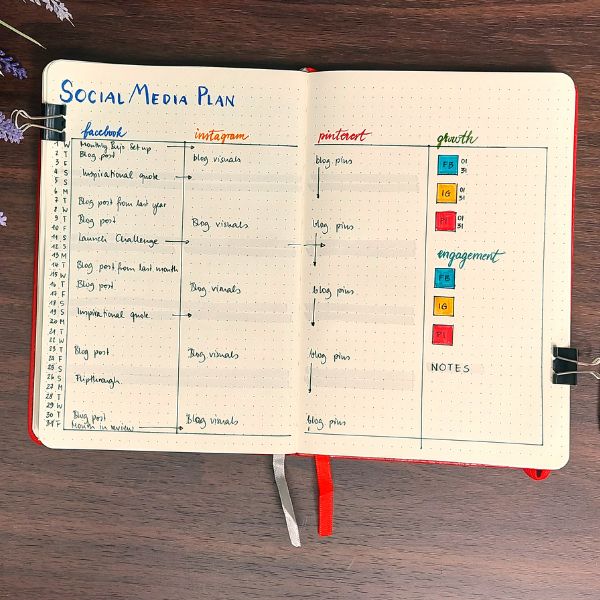
Streamline your social media presence and content creation process with a social media scheduler spread. Plan out your posts, captions, and hashtags for the month ahead, and schedule them in advance to maintain a consistent online presence without the stress of last-minute planning.
Congratulations on your journey to craft your perfect month with these creative bullet journal monthly spreads! By incorporating these spreads into your bullet journaling routine, you’ll gain greater control over your schedule, boost your productivity, and confidently achieve your goals. Remember, bullet journaling is not just about planning—it’s about empowering yourself to live your best life, one month at a time.
Remember to follow us on social media for more bullet journaling tips, inspiration, and community engagement. Please share this article with your friends and colleagues who could use organization and creativity. Let’s inspire and empower each other to make every month organized and beautiful!
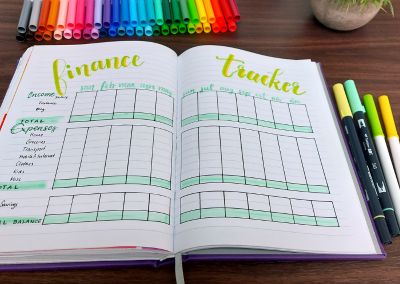
by Nikola | Apr 11, 2024 | Achieve your goals, Bullet Journaling
Mastering the art of budgeting is essential to building financial stability and living a fulfilling life. Understanding and implementing effective budgeting strategies can pave the way to achieving your goals. In this comprehensive guide, we’ll explore the 8 steps of the budgeting process, equipping you with the knowledge and tools to take control of your finances and build a secure future. With actionable insights and real-life examples, you’ll gain the confidence to make informed financial decisions and navigate any challenges that arise along the way.
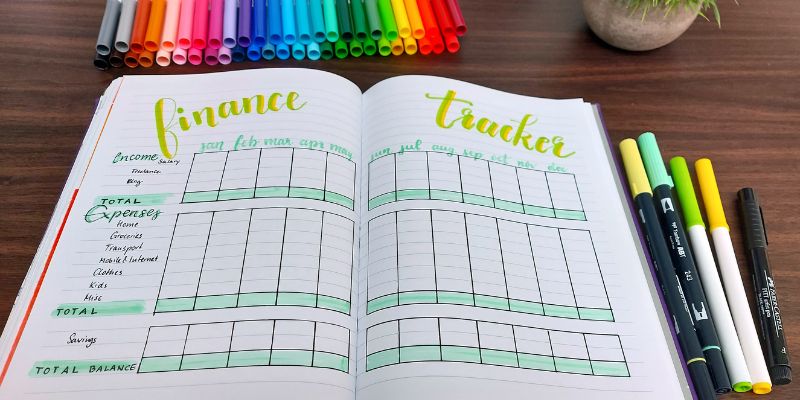
Note: Consider consulting a certified financial planner or advisor for more personalized financial advice tailored to your unique situation.
The Power of Budgeting
Budgeting isn’t just about restricting spending; it’s a powerful tool that empowers you to make informed decisions, prioritize your financial goals, and live a life of abundance within your means. By following a structured budgeting process, you can gain clarity on your income, expenses, and savings, ultimately leading to financial freedom and peace of mind.
Understanding the 8 Steps of Budgeting Process
Step 1: Set Financial Goals
Defining your financial goals is crucial before diving into the nitty-gritty of budgeting. Whether you’re saving for a dream vacation, buying a home, or building an emergency fund, clearly articulated goals provide direction and motivation for your budgeting journey. Take some time to reflect on your aspirations and establish both short-term and long-term objectives.
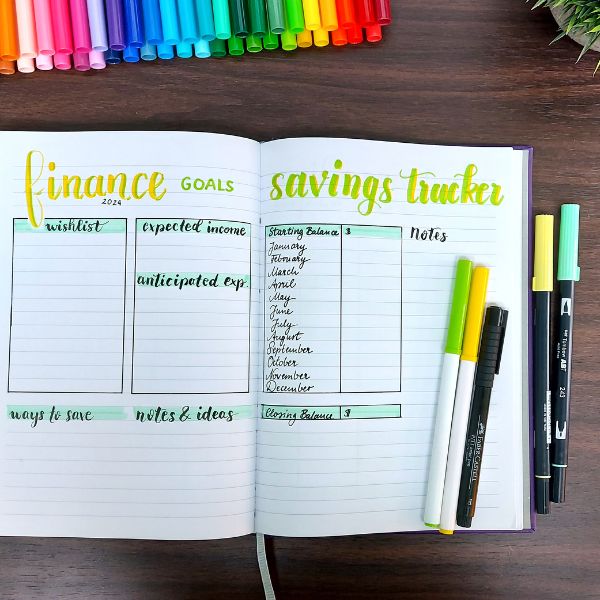
Example
Your goal could be to save $417 per month for the next two years to start your emergency fund of $10,000.
Step 2: Gather Financial Information
You need to understand your current financial situation to create an accurate budget. Gather information about your income, including wages, freelance earnings, investment returns, and any other sources of revenue. Additionally, compile data on your expenses, such as rent or mortgage payments, utilities, groceries, transportation, debt repayments, and discretionary spending.
Step 3: Track Your Spending
Tracking your spending is the cornerstone of effective budgeting. By recording every expenditure, no matter how small, you can identify patterns, pinpoint areas where you’re overspending, and make necessary adjustments. Consider using budgeting apps or spreadsheets to streamline the process and gain insights into your financial habits.
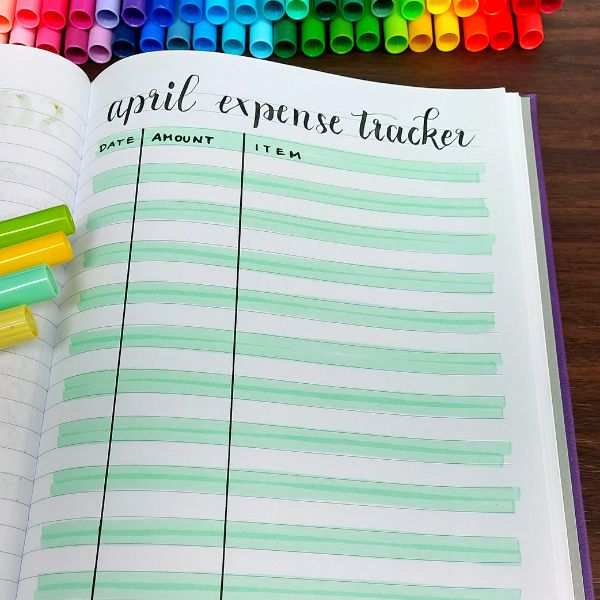
Tip
I use online budgeting software called Wave Apps to categorize my expenses, which helps me visualize where my money goes each month.
Step 4: Create a Budget
With your financial goals and a clear picture of your income and expenses, it’s time to create a budget that aligns with your priorities. Allocate funds to essential categories such as housing, utilities, groceries, transportation, debt repayment, savings, and discretionary spending. Aim to balance covering necessities and saving for the future while allowing room for enjoyment and occasional splurges.
Tip
Discover different budget strategies, such as the 50/30/20 method, the zero-based budget, the pay-yourself-first budget, and more, here.
Step 5: Analyze and Adjust
Budgeting is not a set-it-and-forget-it process; it requires ongoing monitoring and adjustment. Regularly review your budget to assess your progress toward your financial goals and identify areas where you can cut back or reallocate funds. Be flexible and willing to adapt your budget as circumstances change or unexpected expenses arise.
Tip
When you realize you are overspending on a specific category, don’t panic. Brainstorm ways of reducing the expenses in that category and start implementing them step-by-step. Remember, changing your spending habits is as easy or difficult as working out. Getting used to the new routine takes time, and you might slip up occasionally. Take small, achievable steps and keep at it.
Step 6: Build an Emergency Fund
Life is full of surprises, and having an emergency fund can provide a financial safety net when the unexpected occurs. Aim to save at least three to six months’ worth of living expenses in a readily accessible account. This fund can cover unforeseen expenses such as medical emergencies, car repairs, or job loss, allowing you to weather financial storms confidently.
Tip
Talk with your bank or financial advisor to set up a high-yield savings account and automatic monthly contributions to gradually build your emergency fund. You can use one of these printable savings trackers to visualize your progress.
Step 7: Pay Off Debt
Debt can weigh heavily on your financial, emotional and physical health and limit your ability to achieve other goals. Prioritize paying off high-interest debt such as credit card balances or personal loans as quickly as possible. Consider implementing debt repayment strategies such as the debt snowball or debt avalanche method to accelerate your progress and become debt-free sooner.
Tip
Automate, automate, automate. Since you know your monthly expenses, you might have a better understanding and ideas of where to save money. Allocate a monthly amount towards repaying your debt and set it on autopilot. Your bank or financial advisor can help with this.
Step 8: Review and Repeat
As you progress on your budgeting journey, it’s essential to regularly review your financial goals, budget, and spending habits to ensure you’re on track to success. Celebrate your achievements, learn from setbacks, and stay committed to your long-term financial well-being. Remember, budgeting is a lifelong skill that evolves with your circumstances and aspirations.
Tip
In your calendar, set aside time, either weekly, bi-weekly, or monthly, to track and review your budget. Thirty minutes to one hour should be enough to keep you on track. Reviewing your progress and discovering patterns or challenges will keep you motivated toward your financial goals.
Empower Your Financial Future
Mastering the budgeting process is not only about managing your money; it’s about taking control of your future and creating the life you desire. By following these eight steps and incorporating them into your daily routine, you can cultivate healthy financial habits, achieve your goals, and experience true financial freedom. Remember, the journey to financial success begins with a single step – take the first step today and embark on your path to a brighter tomorrow.
Additional Resources:
Invest in your financial future today and reap the rewards tomorrow. Happy budgeting!


 This mesmerizing pattern combines simple grid lines, dots, and circles, creating a hypnotic effect that draws the eye inward. Try using varied line weights and shading to add depth.
This mesmerizing pattern combines simple grid lines, dots, and circles, creating a hypnotic effect that draws the eye inward. Try using varied line weights and shading to add depth. This intricate pattern is your go-to solution when filling a space quickly. Experiment with different motifs within the design for unique results.
This intricate pattern is your go-to solution when filling a space quickly. Experiment with different motifs within the design for unique results. This pattern is perfect for framing headlines or sections in your bullet journal and adds a touch of elegance to any layout. Play with scale for visual interest.
This pattern is perfect for framing headlines or sections in your bullet journal and adds a touch of elegance to any layout. Play with scale for visual interest. A versatile design that effortlessly complements and enhances your existing bullet journal spreads. Leave some areas sparse for contrast.
A versatile design that effortlessly complements and enhances your existing bullet journal spreads. Leave some areas sparse for contrast. This pattern breathes life into even the most mundane daily headlines with its graceful curves and dynamic lines. Try using different line weights or colours.
This pattern breathes life into even the most mundane daily headlines with its graceful curves and dynamic lines. Try using different line weights or colours. Embrace the organic beauty of nature with this leafy, curvy pattern and adapt it to suit your artistic vision. Add details like veining for depth.
Embrace the organic beauty of nature with this leafy, curvy pattern and adapt it to suit your artistic vision. Add details like veining for depth. This pattern is sure to become a favourite for those who appreciate the delicate beauty of feathers. Use shading to create a sense of movement.
This pattern is sure to become a favourite for those who appreciate the delicate beauty of feathers. Use shading to create a sense of movement. With its beachy, floral vibes, this swirling pattern is perfect for injecting a touch of whimsy into your bullet journal.
With its beachy, floral vibes, this swirling pattern is perfect for injecting a touch of whimsy into your bullet journal. Another feather-inspired design that can stand alone or complement other tangle patterns. Vary the sizing for visual interest.
Another feather-inspired design that can stand alone or complement other tangle patterns. Vary the sizing for visual interest. A simple yet eye-catching pattern with interwoven lines and loops that are great for borders, fillers, or ribbons.
A simple yet eye-catching pattern with interwoven lines and loops that are great for borders, fillers, or ribbons.





































